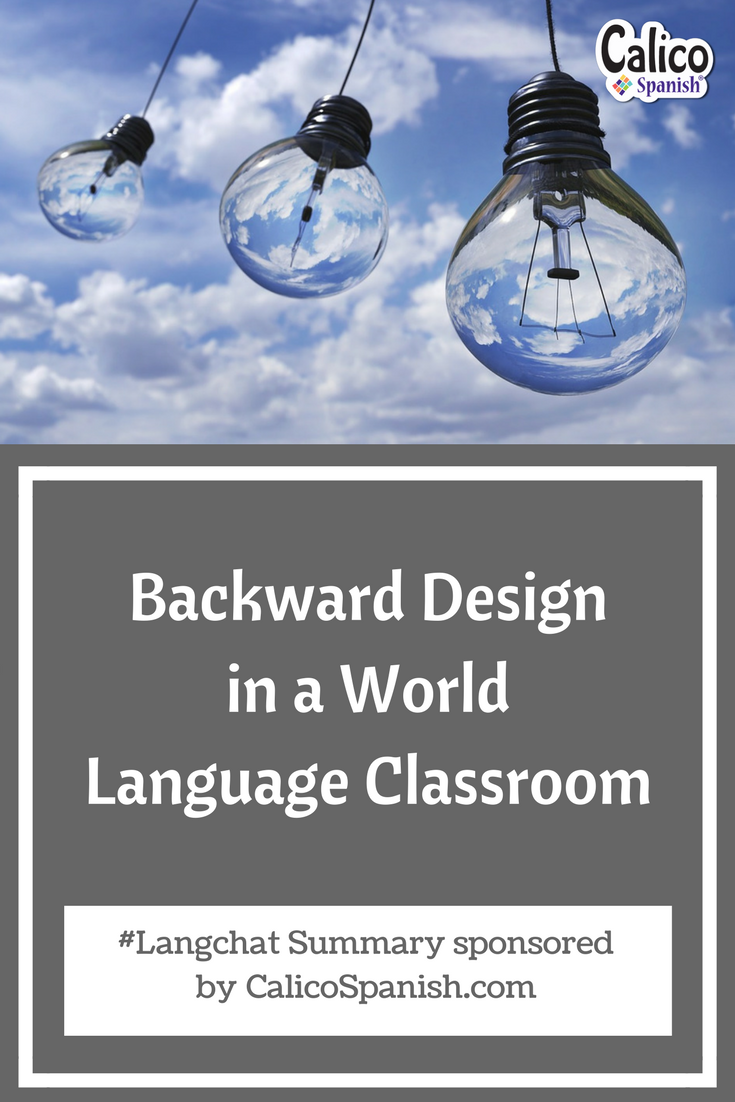Backward Design in a World Language Classroom
 A few weeks ago, the #langchat discussion centered on the details of implementing Backward Design in a World Language Classroom. Backward Design is a concept introduced in the book Understanding by Design and involves planning by establishing the goal first, then how students will show they have achieved the goal, and then the steps they will take to achieve it. The process is the reverse of the traditional ways of lesson planning, thus, the name “backward design.”
A few weeks ago, the #langchat discussion centered on the details of implementing Backward Design in a World Language Classroom. Backward Design is a concept introduced in the book Understanding by Design and involves planning by establishing the goal first, then how students will show they have achieved the goal, and then the steps they will take to achieve it. The process is the reverse of the traditional ways of lesson planning, thus, the name “backward design.”
– Follow the blog on Bloglovin –
This chat included how to determine goals, scaffold resources, incorporate different modes of communication, adapt, and incorporate language structures while using backward design.
Determining Goals for Backward Design
#Langchat participants began the discussion by sharing how they determine the goals they are aiming towards, and teachers agree these goals must appeal to learners. Setting goals can direct the lesson and can give students “something compelling to work towards” (@welangley). “The essential question and theme MUST BE compelling to my audience of learners” (@MmeCarbonneau).
– Like Calico Spanish on Facebook –
Teachers also mentioned using themes or topics as well as proficiency targets and modes of communication to guide goals. @magistertalley said, “I am trying to create broad understanding goals lately. [I] have been focusing on themes or topics as goals too.” @tmsaue1 shared, “unit goals are based on course proficiency targets. Lesson goals are based on unit goals.” @MmeBlouwolff “tries to think by mode, and pair each mode to [her] performance target & unit theme.” Many agreed with @MlleSulewski when she said, “my linguistic goals are based on proficiency levels and trying to move students forward.”
Scaffolding Resources
After discussing goal-setting, #langchat teachers shared how they typically begin selecting and scaffolding resources to achieve their goals. Some language teachers, such as @profedenham, start by incorporating vocabulary. @CadenaSensei often “finds that having source texts to look at” helps with “making better choices about what vocab to prioritize in unit.” @JessieOelke said, “if doing a reading, I look for pre [and] post reading activities.” @MmeBlouwolff said, “for authentic resources, I hunt partly by type. Ideally, I want infographics, a song, a story, articles about teens, [and] maybe a cartoon.” @senorita_leake said:
Find authentic resources and create tasks for each mode of communication based off of them.
“It’s important that resources have comprehensible components to [students] that ALL can take something away from” (@welangley).
– Follow Calico Spanish on Twitter –
Incorporating Different Modes of Communication
#Langchat teachers shared how they incorporate the different modes of communication when using the backward-design technique to plan their lessons. @MlleSulewski said, “I try to do IPA format for all assessments – so, interpretive, interpersonal & presentational. Therefore, [students] will address all in unit.” #Langchat participants agreed that some modes of communication are more important to focus on than others. “Not all modes are created equal. As an #earlylang [teacher] with novice [students], I’m heavy on interpersonal and extremely light on presentational,” said @doriecp. @profedenham shared, “I focus on interpretive with a lot of reading and listening [and] plan interpersonal and presentational when appropriate… around authentic situations.”
Where Do Vocabulary and Grammar/Language Structures Fit in the Design?
There is a variety of ways to incorporate vocabulary and grammar language structures into backward design.
- @senorita_leake shared, “I choose a theme and correlating grammar vocab then look for that in my [authentic resources].”
- @welangley said, “I ask myself ‘what do they NEED to complete this task, and what would be NICE to spice things up?’”
- According to @CatherineKU72, “Grammar structures are seen in chunks that we use to communicate. Vocabulary is student-driven with my support and some guidance.”
- @JessieOelke mentioned that “vocabulary comes up when story-asking.”
- “Learning targets are the GPS, target structures are the vehicle, great prompts are the gasoline!” said @alenord.
Introduce a child you love to a lifelong journey of speaking real Spanish to real people. Click the red button to experience it FREE.
Adapting Mid-Unit
It is often important to adapt lessons mid-unit when realizing a necessary component from the unit plan has been left out. “Isn’t teaching just like sailing?” @VTracy7 asked. “You’re constantly having to make micro adjustments, assessing multiple factors.” Making adjustments is inevitable. “You just have to expect that it will happen and be flexible,” said @senorita_leake. @MmeBlouwolff shared, “using lots of formatives helps me identify what I’ve left out. Filling in isn’t too hard, it’s seeing the holes.” @MlleSulewski added, “another sneaky way around the problem is creating prompt / task that leads [students] to ask for the missing component.” @magistertalley has “found that being open with [students] throughout the whole process is best.”
– Follow us on Instagram too! –
Thank You
Thank you to all who participated in the discussion on Backward Design in a World Language Classroom. Thank you to our lead moderator Megan (@MlleSulewski) for guiding this chat! Have a topic you’d like to discuss? Check out the #langchat wiki and suggest a topic!






No Comments